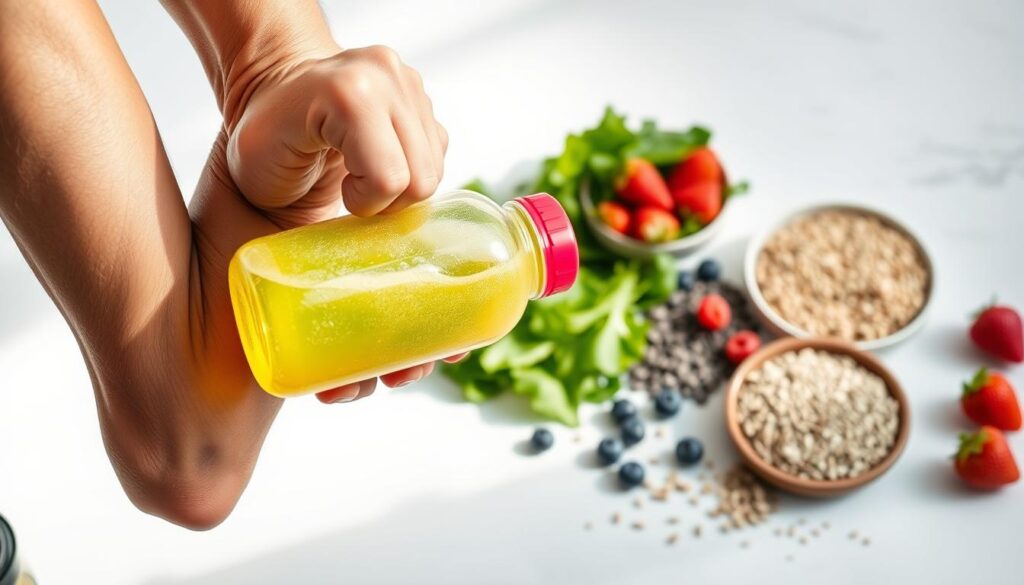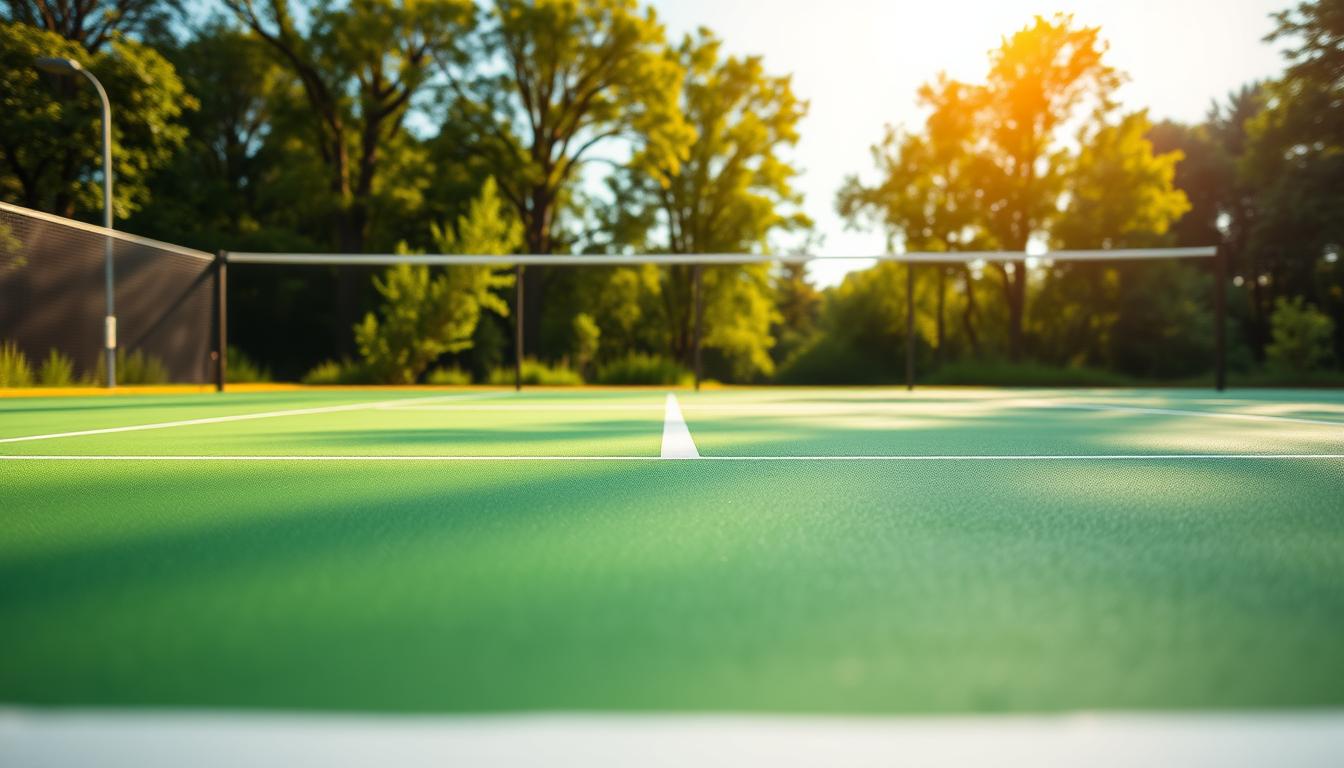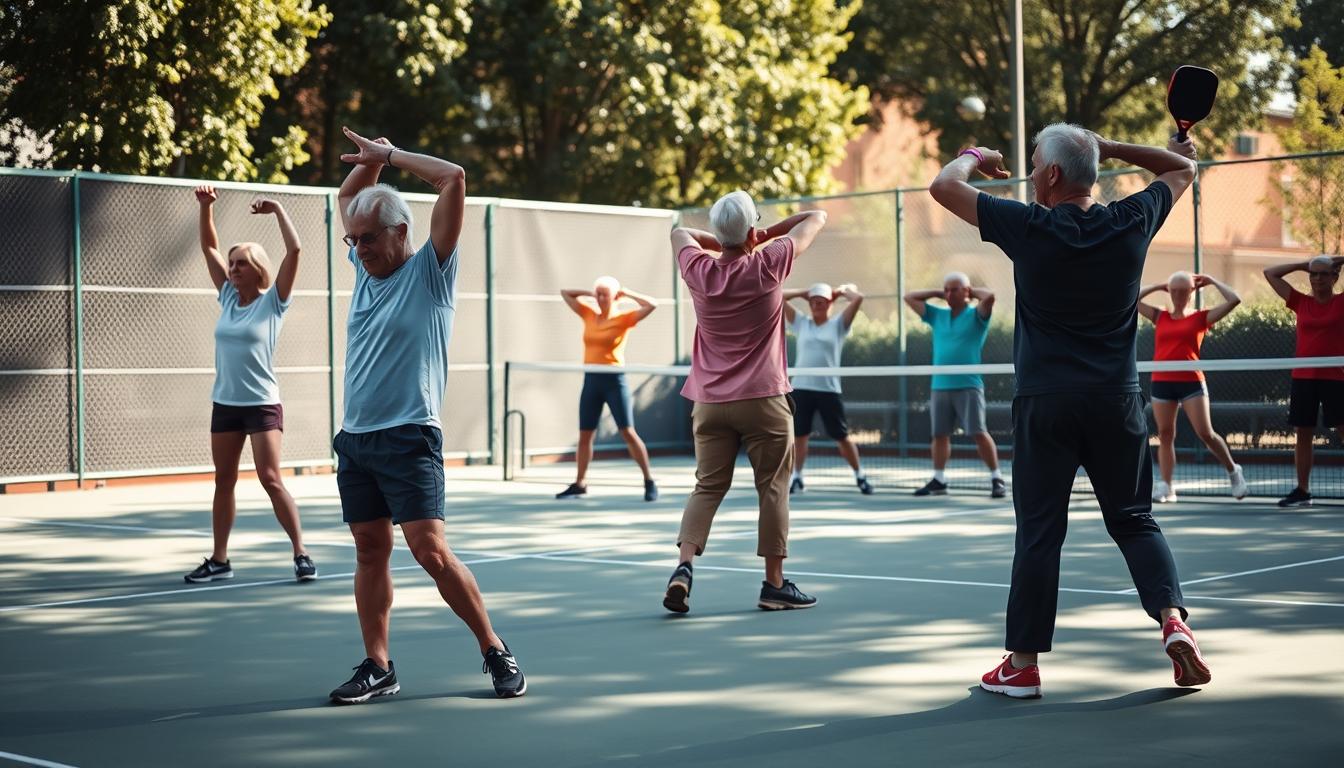Can a clear plan of food, rest, and smart training help older players stay energetic and enjoy the game for years?
This guide gives practical steps for diet, off-court conditioning, and planned recovery so your body recovers faster and you gain confidence on the court.
Coach Bob Savar, a PPR-certified instructor and author, notes reduced flexibility and slower recovery are common. He recommends hydration with water with a pinch of electrolytes and sensible strength work instead of sugary drinks or too much caffeine.
Expect simple, repeatable habits: balanced plant proteins, scheduled rest days, dynamic warm-ups, and lightweight paddles with supportive shoes to reduce joint strain.
Research cited by SilverSneakers shows regular play can improve blood pressure, cholesterol, and cardiorespiratory fitness in weeks. Use that social energy to build steady routines that protect your health and extend your time on the court.
Why strength matters after 50 for better pickleball performance
After midlife, targeted resistance work becomes a key tool to keep court movement quick and pain-free.
Health and game benefits: Regular sessions of play and training improve blood pressure, cholesterol, and cardiorespiratory fitness in a matter of weeks. That rise in fitness feeds stamina and keeps matches fun rather than draining.
Mood and social gains: Group competition and steady activity lower depression risk and encourage routine. Better mood helps players stick with conditioning, which circles back to improved on-court performance.
Common challenges with age
Many adults notice reduced flexibility, joint stiffness, and slower recovery. Women often report lower-body stability concerns; men may feel more upper-body tightness.
“Prioritize core and leg power, joint responsiveness, and mobility work to stay resilient in play.” — Bob Savar
- Strength protects joints, preserves muscle, and makes lateral starts and pivots feel easier.
- Improved fitness markers support longer, higher-energy sessions and better game consistency.
- Two to three strength sessions per week help maintain balance, quick reactions, and braking power.

Vegan fuel and hydration basics to power your game
Simple plate patterns and proper hydration help aging muscles stay ready for court time. Use clear, repeatable choices so your body hits steady energy levels for training and matches.
Balanced plant-based macros for muscle and energy
Build meals around legumes, soy, and whole grains to cover essential amino acids. Prioritize slow carbs before exercise and modest fast carbs after play to refill glycogen without adding unwanted weight.
Protein targets and smart sources for aging muscles
Aim for 1.2–2.0 g/kg bodyweight across the day and spread intake over meals. Include tofu, tempeh, edamame, and fortified plant dairy to support recovery and core function between sessions.
“Water with a pinch of electrolytes beats sugary sports drinks and limits energy spikes and crashes.”
Hydration done right: water plus electrolytes, not sugar spikes
Hydrate before and during play with plain water and a pinch of electrolytes. Limit caffeine so energy stays even through the day.

| Food | Protein (per serving) | Best time | Notes |
|---|---|---|---|
| Tofu (100 g) | 8 g | Any meal | Complete protein, versatile |
| Quinoa (1 cup cooked) | 8 g | Post-session | Good carb+protein mix |
| Edamame (1 cup) | 17 g | Snack or meal | High protein, easy digestion |
- Keep protein at each meal, color on the plate, and fluids consistent.
- Track how foods affect your play and adjust portions for steady output.
Pickleball vegan over 50 strength maintenance
A simple map of workouts, play dates, and rest days prevents fatigue and keeps progress steady.
Coach Bob Savar recommends capping court sessions at four times per week and limiting play to one to two hours each session. That cadence builds stamina while cutting risk of overload.
Your weekly plan: strength, cardio, court time, and rest days
Aim for two to three full-body workout sessions per week. Leave ~48 hours before stressing the same muscle groups again so muscle adapts rather than breaks down.
Include one low-impact cardio slot per week — brisk walking, cycling, or rowing — to support heart health without adding joint stress.
How often to play per week without overdoing it
Play two to four times per week, with harder and easier days rotated to manage fatigue. If soreness lasts more than two days, cut volume or swap a play block for active recovery.
“Listen to your body: shorter, focused sessions beat long, frequent ones when recovery lags.” — Bob Savar
- Two to three workouts per week + two to four play times keeps progress steady.
- One cardio day protects endurance without taxing joints.
- At least one full rest day preserves long-term momentum.
- Log times, sets, and outcomes to fine-tune the routine.
| Weekly Slot | Recommended Times | Notes |
|---|---|---|
| Strength workouts | 2–3 times per week | Full-body splits, 48-hour recovery window |
| Cardio | 1 time per week | Low-impact: walking, cycling, or rowing |
| Court play | 2–4 times per week | 1–2 hours per session; cap at four sessions |
| Rest | 1+ days per week | Full recovery or light active recovery |
Warm-up, mobility, and movement prep before you hit the court
Spend a few focused minutes on mobility and footwork to reduce injury risk and sharpen timing. Start at low intensity and build gently so the feet, knees, shoulders, and back are ready for fast changes.
Dynamic moves that protect knees, shoulders, and back
Begin with 5–8 minutes of leg swings, arm circles, and gentle lunges to raise temperature and improve mobility. Add scapular slides and controlled reaches to prime the shoulder complex while keeping the back neutral.
Balance and footwork primers: lateral shuffles and single-leg work
Include lateral shuffles and single-leg balance drills to tune the feet and ankles for side-to-side movement. Keep contacts quiet and centered to train balance and reduce load on the knee.
Safety first: what to avoid, including running backward
Avoid running backward to cut injury risk. Instead, turn sideways to sprint or call a partner switch to recover a ball safely. Use sport-specific footwear, lace snugly, and check court traction mid-session.
| Prep Drill | Duration | Primary Target |
|---|---|---|
| Leg swings + arm circles | 2–3 min | Hip mobility, shoulder ROM |
| Lateral shuffles | 1–2 min | Feet, ankles, balance |
| Single-leg balance + mini squats | 2–3 min | Knee alignment, foot arches |
Strength training that translates to power, balance, and injury resilience
Simple, repeatable exercises that mirror court demands give reliable gains in power and stability. Aim for two to three sessions a week and prioritize form over heavy weight.
Lower body and core: squats, lunges, hip hinges, and planks
Build base power with squats, Romanian deadlifts, lunges, and hip thrusts. These movements train braking, re‑acceleration, and single‑leg control.
Add planks, Russian twists, and leg raises to improve anti‑rotation and transfer force from the hips to the torso.
Upper body for paddle control: pushes, pulls, and shoulder care
Balance push patterns (push‑ups, shoulder press, chest press) with pulls (rows, assisted pull‑ups). That helps arm endurance and safer shoulder mechanics.
Include banded external rotations and scapular work to protect tissues and smooth the paddle path.
Form, progressive overload, and recovery between sessions
Start with body weight or light loads and add small increments weekly. Track reps, tempo, or weight so progress is steady and measured.
Leave about 48 hours before stressing the same leg or shoulder patterns again. Use dynamic warm‑ups and finish with brief static stretching for flexibility.
Gear and support: footwear, lighter paddles, and joint protection
Choose court shoes with good traction and a lighter paddle to lower cumulative arm load. Consider knee sleeves or braces if you have prior issues.
Log sessions, watch recovery, and adjust volume so muscles rebuild stronger and play feels more reliable.
Conclusion
Small, repeatable habits make big differences in muscle resilience and enjoyment of the game. Anchor your week with two to three strength sessions and one simple workout pattern so recovery and progress stay steady.
Plan court play and cardio around rest days, watch soreness, and avoid risky moves that raise the chance of injury or injuries. Keep mobility and light cardio in the mix to protect your back and boost fitness across levels.
Use a weekly checklist to schedule training, times, and days, then reassess monthly. Track how you feel and trim what does not serve your health or life goals.
Enjoy the social side of pickleball and the game itself—consistent, smart work yields better muscle, fewer setbacks, and more time on the court.




